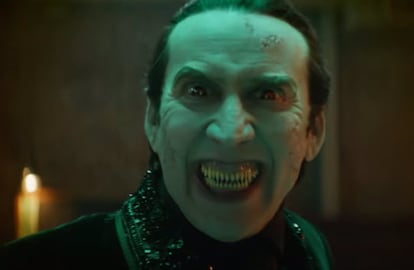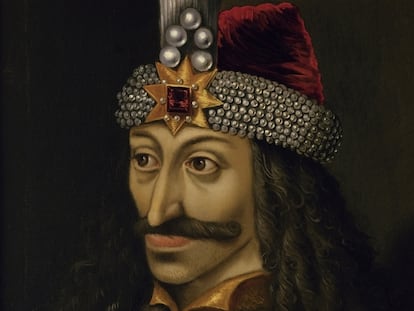Ten great movies that resurrect the myth of Dracula
The premiere of ‘Renfield,’ with Nicolas Cage playing the Transylvanian vampire, brings one of the most fascinating villains of the horror genre back to the big screen


We can’t seem to get enough of vampires, bloodsuckers, incubi, succubi, revenants and nachzehrers. And, above all — especially in the world of cinema — Dracula, or Nosferatu. Nosferatu (1922) was the first film adaptation to break the copyright held by Florence Stoker, the widow of Bram Stoker. The Irish author — who gathered various occult legends related to Vlad Draculea, or Vlad the Impaler — wrote the novel Dracula in 1897. Funnily enough, the book’s namesake, the Prince of Darkness, appears in barely 10% of the pages.
In addition to its literary influence, Dracula went on to deeply impact the audiovisual world. More than a hundred productions are based on the character. There have been Bollywood versions, Blaxploitation flicks (such as the 1972 Blacula), artistic versions by Andy Warhold and 3D productions. There have been Pakistani, Turkish, Mexican, American and British Draculas… and the 21st century has only multiplied the nationalities.
The latest adaptation of the classic novel is Renfield, a comedy about the manservant who accompanies Dracula on his eternal journey in search of fresh blood. Dracula is played by Nicolas Cage, while the servant is played by Nicholas Hoult, who will also be in the next version of Nosferatu, directed by Robert Eggers.
1) Nosferatu (1922). This is the first (and still the most fascinating) of the films featuring Dracula, aka Nosferatu (via his mundane, mortal incarnation, Count Orlok). Friedrich Wilhelm Murnau’s film has survived a century and still maintains its mystery, its cunning construction of environments and its reflection on identity and the individual. Max Schreck’s portrayal of the Prince of Darkness still makes your hair stand on end.
2) Bram Stoker’s Dracula (1992). Francis Ford Coppola undertook a canonical revision of Stoker’s creature at the beginning of the 1990s. There’s Transylvania, a boat trip to London, wonderful Victorian imagery, a prodigious soundtrack by Wojciech Kilar… and Gary Oldman in his prime. In this adaptation, singer Tom Waits — who feeds on flies — plays a masterful Renfield.
3) Dracula (1931). The cape, the iconic black hairstyle (held in place with gel), the sensual, toying game... many of the characteristic elements of Dracula were born in this film by Tod Browning, who found his perfect Dracula in Bela Lugosi, a Romanian actor born in the Austro-Hungarian Empire. Lugosi had already been giving life to the mythical vampire on Broadway for four years with his very marked English. Due to his foreign status, he had to accept a lower salary than his co-stars. When he died, the actor was buried with a black cape... but not the one worn by his character: that one was auctioned off by his son in 2011.
4) Dracula (2020). Just before the pandemic, the creators of the series Sherlock — Mark Gatiss and Steven Moffat (big fans of the 1977 BBC version of Dracula) — embarked on this three-episode version for Netflix. The performance of Danish actor Claes Bang recalls legendary portrayals of Dracula in previous films. Even his Slovakian castle shown in the first episode is the same one that Nosferatu (1922) was filmed in.
5) Dracula (1958). From 1958 to 1976, Christopher Lee played Dracula nine times (excluding cameos). The English production company Hammer — specializing in gothic horror films — put Lee (who had given life to Frankenstein a year earlier) together with director Terence Fisher. Both created a wonderful Dracula, who has marked the imagination of several generations of spectators. He is tall, elegant, sinister and ruthless.
6) Nosferatu the Vampyre (1979). At the end of the 1970s, Werner Herzog returned to classic German expressionism, which was not an easy challenge. However, he had a superb Klaus Kinski to bolster his work. Although the actor-director pair hated each other for decades (“Even the rats were better on this set than Klaus,” Herzog once complained), this Nosferatu film is a tangible demonstration of Kinski’s ability to create iconic villains. Curiously, in one of Lee’s films — the version from 1970 — Kinski played the role of Renfield.
7) Dracula (1979). Frank Langella played Dracula in film and theater. His vampire is based on the undercurrent of blue blood: above all he is a nobleman, full of charm, gentle, with only two problems: he is immortal, and he needs human blood to survive.
8) Count Dracula (1977). This is one of the least known adaptations and, on the other hand, one of the most interesting. In 1977, the BBC broadcast (there is a 155-minute version, another divided into three episodes and a third divided in two) its own vision of Stoker’s novel — quite faithful to the literary work — with Frenchman Louis Jourdan playing a sexy, mesmerizing, captivating count… a master of the “undead.” It’s the series that most influenced the creators of the Netflix version in 2020.
9) Dracula: Pages from a Virgin’s Diary (2002). The Canadian filmmaker Guy Maddin created this ballet version. It’s in black and white, silent and respectful of gothic terror, with Zhang Wei-Qiang as Dracula… and the Royal Winnipeg Ballet in the background. Initially recorded for television, after winning the Sitges Film Festival in Catalonia and receiving praise from critics, it ended up being released in theaters.
10) Love at first bite (1979). George Hamilton — who imitates Bela Lugosi with his accent — starred in this black comedy in which the Romanian nobleman travels to New York during the disco era, after his love affair comes to an end. In 1979, there were five Draculas playing in theaters, but this was a big blockbuster.
Sign up for our weekly newsletter to get more English-language news coverage from EL PAÍS USA Edition
Tu suscripción se está usando en otro dispositivo
¿Quieres añadir otro usuario a tu suscripción?
Si continúas leyendo en este dispositivo, no se podrá leer en el otro.
FlechaTu suscripción se está usando en otro dispositivo y solo puedes acceder a EL PAÍS desde un dispositivo a la vez.
Si quieres compartir tu cuenta, cambia tu suscripción a la modalidad Premium, así podrás añadir otro usuario. Cada uno accederá con su propia cuenta de email, lo que os permitirá personalizar vuestra experiencia en EL PAÍS.
¿Tienes una suscripción de empresa? Accede aquí para contratar más cuentas.
En el caso de no saber quién está usando tu cuenta, te recomendamos cambiar tu contraseña aquí.
Si decides continuar compartiendo tu cuenta, este mensaje se mostrará en tu dispositivo y en el de la otra persona que está usando tu cuenta de forma indefinida, afectando a tu experiencia de lectura. Puedes consultar aquí los términos y condiciones de la suscripción digital.
More information
Archived In
Últimas noticias
The new victims of the Republican war on Obamacare: Millions hit by soaring health insurance premiums
A country divided on migrant rights: Some US states expand protections while others restrict them
Venezuela authorizes the release of another 87 political prisoners
There is as much life left to discover on planet Earth as that which is already known
Most viewed
- David King, chemist: ‘There are scientists studying how to cool the planet; nobody should stop these experiments from happening’
- Reinhard Genzel, Nobel laureate in physics: ‘One-minute videos will never give you the truth’
- Oona Chaplin: ‘I told James Cameron that I was living in a treehouse and starting a permaculture project with a friend’
- Sinaloa Cartel war is taking its toll on Los Chapitos
- The Interoceanic Train, the Mexican alternative to the Panama Canal









































